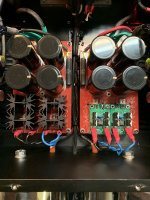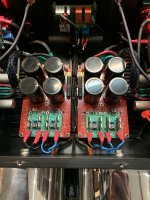I watched that video a little while ago. Neat stuff. I'm pretty sure at these voltages it does not make a difference audibly. Thanks for sharing that.
I watched that video a little while ago. Neat stuff. I'm pretty sure at these voltages it does not make a difference audibly. Thanks for sharing that.
Great video!!
To really judge the impact of the outside foil position you would need to do a test with real world impedances and levels of hum/noise. Using a high impedance scope input to terminate the capacitor in the tests lets you see the differences with the 1megohm input impedance of the scope in parallel with the Xc of the capacitor under test. Small capacitors should produce more of a difference due to the higher impedance at 60hz. It makes sense that there would be a difference and he explains it very carefully and makes it easy to understand.
I don’t think I would go to the trouble of making that electronic box to identify the outside foil end of the caps though. I would just use a DPDT switch to do it. It would have been more useful IMO to put an amplifier in the box and output the hum to a DVM. You could even have a gain adjustment that would be used to just barely light up an LED in one position. Then switch positions and see if the LED gets brighter or goes out. That way you would not need a scope or a meter.
If we look at a 4.7uf cap on the input of a USSA5 the Xc at 60hz is about 560 ohms. So that is the impedance you are trying to generate 60hz hum into. This is perhaps one of the reasons that you see large electrolytic caps as input caps on a lot of pro audio equipment. 100uf is common, so that would be only about 27 ohms at 60hz. On the other hand I am building a Baby Huey EL84 amp with interstage coupling caps of .1uf which would be 27k ohms. So I would expect this effect to be more of an issue in that case. I still have a couple of those caps left and I think I will run downstairs to the shop and test them to see if they are consistent in orientation.
Last edited:
If you use Jantzen caps here is a link from an Australian distributor regarding the inner/ outer foil:
Superior Z-Cap
Superior Z-Cap
In theory. Ground towards the highest impedance or ground so noise will be reduced
However for input ..outer foil should be in the input side. Inner foil is facing jfet
Output, inner foil face inside
It works ..
The result is less bright , more darker background .less noise per se
Ecq Panasonic ..the outer foil is always at the end of the letter. So install against the letters in direction of signal flow for ussa fssa
It also works for the bypass caps .or filter caps
However for input ..outer foil should be in the input side. Inner foil is facing jfet
Output, inner foil face inside
It works ..
The result is less bright , more darker background .less noise per se
Ecq Panasonic ..the outer foil is always at the end of the letter. So install against the letters in direction of signal flow for ussa fssa
It also works for the bypass caps .or filter caps
Last edited:
Anyway ... Coupling caps . I go reasonable quality ..tried alot of types ..after burn in ..nobody really notice that small difference . I tried till duelund cast . Honestly we made alot of tube preamp ..we couldn't really make out which is which eventually, placebo effect bwahaha
But one cap is really special .vcap cutf ..if u can afford it ..and natoriously long burn in. That is special ..and we can know it's vcap
And another thing which makes a huge difference.. try cardas litz wire ..copper ones for signal
But one cap is really special .vcap cutf ..if u can afford it ..and natoriously long burn in. That is special ..and we can know it's vcap
And another thing which makes a huge difference.. try cardas litz wire ..copper ones for signal
Last edited:
Has anyone compared a cap multiplier to a CRC power supply for this amp?
I was ready to make a cap multiplier but had second thoughts.
I was ready to make a cap multiplier but had second thoughts.
I started with CRC, then CRCRC then SLB.
I am not good at describing how it sounds, but i can tell straight away the mid and high are sweeter, improved clarity. Absolutely no hums and noise when i put my ear to the speakers.
With CRC and CRCRC, i still can hear the 50Hz hums that i can't rid off.
Go try it, you will like it.
I am not good at describing how it sounds, but i can tell straight away the mid and high are sweeter, improved clarity. Absolutely no hums and noise when i put my ear to the speakers.
With CRC and CRCRC, i still can hear the 50Hz hums that i can't rid off.
Go try it, you will like it.
OK you have convinced me to use cap multipliers.
I think Nikosokey used them as well but hasn't told us if he likes them.
Unfortunately the Australian dollar has died and buying two boards will set me back $100, so I'll make my own.🙄
I think Nikosokey used them as well but hasn't told us if he likes them.
Unfortunately the Australian dollar has died and buying two boards will set me back $100, so I'll make my own.🙄
I started with CRC, then CRCRC then SLB.
I am not good at describing how it sounds, but i can tell straight away the mid and high are sweeter, improved clarity. Absolutely no hums and noise when i put my ear to the speakers.
With CRC and CRCRC, i still can hear the 50Hz hums that i can't rid off.
Go try it, you will like it.
Which boards did you use Meanie? Perhaps you could post a schematic?
Many thanks.
I started with CRC, then CRCRC then SLB.
....... Absolutely no hums and noise when i put my ear to the speakers.
With CRC and CRCRC, i still can hear the 50Hz hums that i can't rid off.
Go try it, you will like it.
I agree with Meanie. If using the SLB is not an option, definitely use the LT4320 ideal rectifier instead of a conventional silicon bridge rectifier. That is a key component to the SLB along with the grounding method.
I’ve used a few (7) and will not go back to a straight CRC for Class A amplifiers.
Last edited:
@ meanie
Of Course!!! I know I am old but hadn't realised that I am also THAT stupid...😱
Many thanks 🙂
Of Course!!! I know I am old but hadn't realised that I am also THAT stupid...😱
Many thanks 🙂
Hi Brianco,
I thought you were asking for the schematics of the CRC psu’s Meanie used!
Hahaha!! 😀 😉
I thought you were asking for the schematics of the CRC psu’s Meanie used!
Hahaha!! 😀 😉
I have a pair of SLB that I will use in a future amplifier. My USSA 5 is using a CRC PSU and it is totally silent, even with my ear directly on the tweeter, you would believe the amplifier is turned off. I wanted to use the SLB for the USSA 5 but with 4V drop, I would need to change my transformers, which will never happen because I bought those very nice encapsulated Toroidy transfos and I just love them. But I'm planning to replace the diode bridge with the LT4320. They're already assembled and tested, just need time to migrate them over.
Do
Do
Let us know IF you hear any sonic improvement doing so, I am quite curious about the effect of bridges
Claude
Claude
Let us know IF you hear any sonic improvement doing so, I am quite curious about the effect of bridges
Claude
Hi Claude,
Will do for sure
Do
Cm definitely cleaner quieter and accurate .. But it will take out some bloom/texture . I think it's more of system integration which sounds better. I personally like a well executed clc or crc better. It's more musical and more tube like tone. Heavier sound. I compared them on goldmund project.
Crc... talk to pinnocchio and read through Bob Cordell power supply thread. My fssa is zero noise very quiet also.. Pinnocchio gave me, some tips on cabling and positioning. That helps Alot.
Better still CLC.
Oh yea.. Pinnocchio is the expert advanced guy here... He is one of the people I trust and learn from..
Crc... talk to pinnocchio and read through Bob Cordell power supply thread. My fssa is zero noise very quiet also.. Pinnocchio gave me, some tips on cabling and positioning. That helps Alot.
Better still CLC.
Oh yea.. Pinnocchio is the expert advanced guy here... He is one of the people I trust and learn from..
Last edited:
Here's the USSA5 with LT4320 added to the PSUs. It gave me an extra 2.2Vdc. Running the amp modules at 1.5A and the amp hovers around 50-52 Celcius, still comfortable!
I have not yet listened to it but will do later on.
Here's a few pictures, sorry, a little dusty as it picked up some dust over time...
Ciao!
Do


I have not yet listened to it but will do later on.
Here's a few pictures, sorry, a little dusty as it picked up some dust over time...
Ciao!
Do


Do,
Nice work with the LT4320 "upgrade".
Look forward to your listening impressions.
Nice work with the LT4320 "upgrade".
Look forward to your listening impressions.
- Home
- Amplifiers
- Solid State
- USSA-5 Build with Review